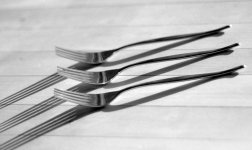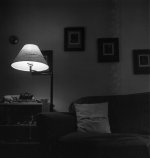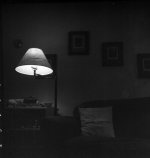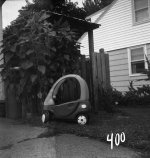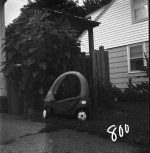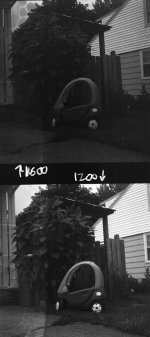dreilly
Chillin' in Geneva
- Local time
- 6:50 PM
- Joined
- Dec 25, 2004
- Messages
- 1,045
Hi all,
As some of you know, I've begun my developing journey with diafine and a lot of expired black and white film. Included in that lot was Delta 100 and 400 (not yet tried), some Neopan 400 and a lot of Tri-X.
The Neopan tests I ran came out great at the box recommended speed for diafine. The Tri-X seems to be a different story, however. It's dated 1990 or 1992, and was possibly cold-stored (since it's not been mine for long, I can't know for sure.)
I ran three ASA test strips yesterday and developed the first two of them today. I set the camera up on a tripod and shot the same indoor (LV8) and overcast outdoor scene (LV12) with three frames for each ASA setting (using a range of equal shutter/aperture combinations to control for a possibly unreliable shutter, though it tested well itself). Just looking at the negatives on the hanger, it appears the 400-800 range came out far better than the higher range, which on the indoor roll are seriously underexposed. So I think my Tri-X is only getting a one-stop push at the most, and might be best shot at box in low-contrast lighting.
Does this jive with what age might do to black and white film? I've heard some folks shoot Tri-X at 1000 for diafine (in medium format), which isn't far off from 800. On the other hand, I'm not getting the 1250 or 1600 that seems like the more common choice for folks.
I'll develop the third test roll, which was done outside in high-contrast light (sunny 16) tomorrow. Thanks!
I've got about 60 more rolls of this Tri-X, so I really hope to figure out how to shoot it!
As some of you know, I've begun my developing journey with diafine and a lot of expired black and white film. Included in that lot was Delta 100 and 400 (not yet tried), some Neopan 400 and a lot of Tri-X.
The Neopan tests I ran came out great at the box recommended speed for diafine. The Tri-X seems to be a different story, however. It's dated 1990 or 1992, and was possibly cold-stored (since it's not been mine for long, I can't know for sure.)
I ran three ASA test strips yesterday and developed the first two of them today. I set the camera up on a tripod and shot the same indoor (LV8) and overcast outdoor scene (LV12) with three frames for each ASA setting (using a range of equal shutter/aperture combinations to control for a possibly unreliable shutter, though it tested well itself). Just looking at the negatives on the hanger, it appears the 400-800 range came out far better than the higher range, which on the indoor roll are seriously underexposed. So I think my Tri-X is only getting a one-stop push at the most, and might be best shot at box in low-contrast lighting.
Does this jive with what age might do to black and white film? I've heard some folks shoot Tri-X at 1000 for diafine (in medium format), which isn't far off from 800. On the other hand, I'm not getting the 1250 or 1600 that seems like the more common choice for folks.
I'll develop the third test roll, which was done outside in high-contrast light (sunny 16) tomorrow. Thanks!
I've got about 60 more rolls of this Tri-X, so I really hope to figure out how to shoot it!




